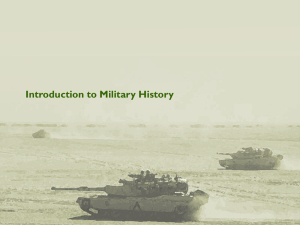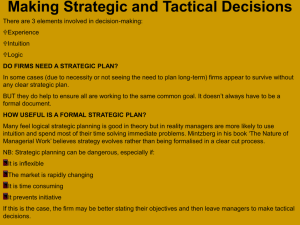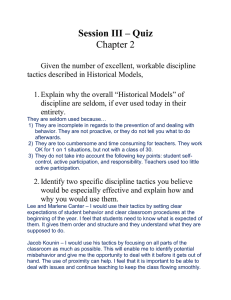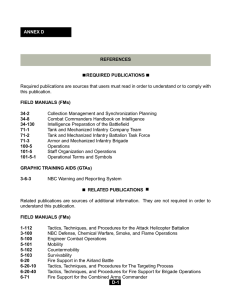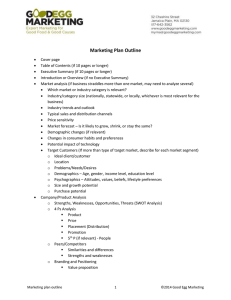Understanding Tactics Chapter 1
advertisement
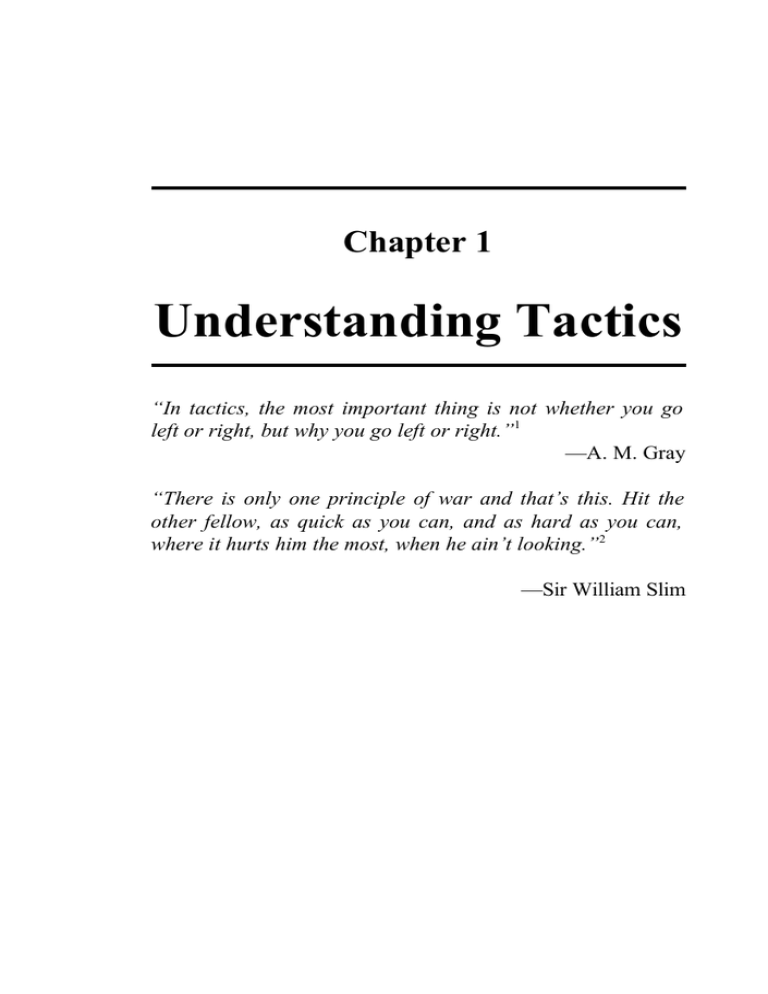
Chapter 1 Understanding Tactics “In tactics, the most important thing is not whether you go left or right, but why you go left or right.”1 —A. M. Gray “There is only one principle of war and that’s this. Hit the other fellow, as quick as you can, and as hard as you can, where it hurts him the most, when he ain’t looking.”2 —Sir William Slim MCDP 1-3 Understanding Tactics T his book is about winning in combat. Winning requires a thorough understanding and knowledge of tactics. But what is tactics? AN ART AND A SCIENCE Tactics is “the art and science of winning engagements and battles. It includes the use of firepower and maneuver, the integration of different arms and the immediate exploitation of success to defeat the enemy,”3 as well as the sustainment of forces during combat. It also “includes the technical application of combat power, which consists of those techniques and procedures for accomplishing specific tasks within a tactical action.”4 This description is from Marine Corps doctrine and reflects our approach to tactics. What does it tell us? Tactics refers to the concepts and methods we use to accomplish a particular objective in either combat or military operations other than war. In war, tactics is the application of combat power to defeat the enemy in engagements and battles. Combat power is the total destructive force we can bring to bear against the enemy; it is a unique product of a variety of physical, moral, and mental factors.5 Tactics results in the actions and counteractions between opposing forces. It includes the use of maneuver, supported by the application and coordination of fires, to gain advantage in order to defeat the enemy. 3 Tactics MCDP 1-3 In military operations other than war, tactics may be the schemes and methods by which we perform other missions, such as to control a crowd or to provide a secure environment for the delivery of food, medicine, or supplies to a nation or people in need. As stated in the definition, tactics is a combination of art and science to gain victory over the enemy. The art of tactics lies in how we creatively form and apply military force in a given situation. It involves the creation, positioning, and maneuver of combat power. When do we flank the enemy, and when do we ambush him? When do we attack, and when do we infiltrate? How do we use speed and momentum to achieve a decisive advantage? This creativity is a developed capacity, acquired through education, practice, and experi- ence. The science of tactics lies in the technical application of combat power. It includes mastering the techniques and procedures that contribute to the development of warfighting skills such as marksmanship, navigation, gunnery, and close air support. The execution of these techniques and procedures must become second nature for us; this requires intensive and continuous training. Without mastery of basic warfighting skills, artistry and creativity in their application are impossible. 4 MCDP 1-3 Understanding Tactics Now that we have examined the art and science of tactics, let us look at how we use tactics to complement strategy and campaigning. Strategy and campaigning bring our forces to a particular place at a particular time. We use tactics to win in combat. A war typically involves many individual engagements that form a continuous fabric of activity. Sometimes a cluster of engagements flows together to make up a battle that may last for hours, days, or even several weeks. Tactical competence is indispensable to victory in such engagements and battles. Leaders at the operational and strategic levels use tactical victories to bring about success in the campaign and, ultimately, in the war as a whole. In combat, our objective is victory. Sometimes this involves the complete destruction of the enemy’s forces; at other times achieving victory may be possible by attacking the enemy’s will to fight. The Marine Corps must be equally prepared to win during both situations—those in which the enemy forces must be completely destroyed (as during World War II), and those in which the complete destruction of the enemy’s forces may not be necessary or even desirable. As the Commanding General of the 1st Marine Division in Des-ert Storm, stated, “Our focus was not on destroying everything. Our focus was on the Iraqi mind and getting behind [it].”6 He knew that the path to victory did not lie in the total destruction of the Iraqi forces, but in undermining their will to fight. 5 Tactics MCDP 1-3 THE ENVIRONMENT The tactical arena is a dynamic, ever-changing environment. The complexity of this environment makes combat chaotic and unpredictable. As an example of confusion and chaos on the battlefield, consider the amphibious assault on the island of Tarawa in November 1943. During the assault, the combination of high casualties, lack of effective communications, and disruption of the 2d and 8th Marine Regiments’ landings on the assault beaches led to a chaotic and nearly disastrous situation for the 2d Marine Division. Units were decimated under heavy fire. Surviving Marines huddled together under a coconut log sea wall in intermingled units without effective communications. Landing craft carrying reinforcements and supplies could not make it over a coral reef to the landing beaches. Only through daring leadership, initiative, and teamwork were Marines able to get off the beach and annihilate the defending Japanese force.7 The violence of combat only increases the level of confusion and chaos. Robert Sherrod, a Time and Life correspondent at Iwo Jima, gave testimony to this chaos in what he called “war at its worst”: The first night on Iwo Jima can only be described as a nightmare in hell. . . . About the beach in the morning lay the 6 MCDP 1-3 Understanding Tactics dead. They had died with the greatest possible violence. Nowhere in the Pacific have I seen such badly mangled bodies. Many were cut squarely in half. Legs and arms lay fifty feet from any body.8 Battle is the collision of opposing forces—animate, interactive, and unpredictable in behavior. Performance varies from week to week, day to day, and even hour to hour as a unit interacts with its environment and the enemy. Military forces are complex systems consisting of individuals and equipment. They interact internally and externally in seemingly chaotic ways. As Clausewitz wrote, “A battalion is made up of individuals, the least important of whom may chance to delay things or . . . make them go wrong.”9 As Marines, we believe the actions of single individuals can have great impact in combat and can also make things go right. For example, Sergeant John Basilone as a machine gunner at Guadalcanal contributed “in large measure to the virtual annihilation of a Japanese regiment.”10 He steadfastly manned his position in the face of repeated wave-type assaults and was instrumental in breaking the enemy’s ability to press the attack, forcing them to retreat without achieving their goals. Battle is also influenced by a variety of external conditions—directions and missions established by authorities, terrain, weather, attitudes of the civilian populace—that often cannot be foreseen. The outcome of combat can only be anticipated in terms of probabilities. 7 Tactics MCDP 1-3 Technology also affects the tactical environment—but not always as anticipated. Technology may reduce uncertainty, and it also may increase it. The Spartans, organized into phalanxes, attacked in close formation, making it easy to see and control one’s forces. Today, tactical formations are less well-defined as distances between elements have increased, complicating command and control. Increased weapons lethality, communications range, and tactical mobility cause us to disperse forces over greater distances. War is more fluid as a result of technology. While the machine gun bogged down warfare in World War I, tactical innovations like the tank, the airplane, and the aircraft carrier made warfare more rapid and free-flowing in World War II. Future battle is likely to become even more chaotic. Although combat in Operation Desert Storm was between fairly well-defined forces in a well-defined space, the forces and operating areas in Vietnam, Somalia, and Grenada were far less well-defined. Enemy units were dispersed and often hidden within the civilian population, making them hard to detect and harder to target. They converged at a time and place of their choosing. Future opponents may choose to fight in this manner to offset our overwhelming superiority in fire- power. This chaotic environment also brings opportunity. Clausewitz wrote about combat, “No other human activity is so continuously . . . bound up with chance.”11 The challenge is 8 MCDP 1-3 Understanding Tactics to recognize opportunity when it occurs in the midst of chaos and uncertainty and to seize it to obtain a clear, unambiguous victory. When viewed through time, even the most chaotic of systems may reveal recurring patterns that may then be exploited. The experienced tactician will look for these recurring patterns that can be exploited to advantage. HOW WE VIEW COMBAT AND HOW WE FIGHT How we view the combat environment in large part determines how we operate in it. There are two competing views of combat. Some see it in simple terms as if the battle and the environment represent a closed mechanical system. This “deterministic” view argues that combat is predictable. Among the advocates of this view are military theorists who seek prescriptive rules for battle and analysts who predict battle outcomes based upon force ratios. The other view is that combat is chaotic and uncertain. In this “probabilistic” view, battle is seen as a complex phenomenon in which participants interact with one another and respond and adapt to their environment. The probabilistic viewpoint sees combat as unpredictable. The distinctions between these two views of combat are im-portant. They drive the choices commanders make in combat. 9 Tactics MCDP 1-3 The deterministic view of combat often leads to centralized control. It can be a recipe for micromanagement stifling the initiative subordinates need to deal with combat’s inevitable uncertainties. Overly prescriptive orders and plans inhibit a unit’s ability to cope with uncertainty and change. Eventually, the unit, inflexible and unable to adapt, may be overwhelmed by events. The probabilistic view of combat recognizes that the complexity and uncertainty of war leads to a more decentralized approach to control. We place greater trust in subordinates to achieve a desired result. Through use of mission orders and commander’s intent, subordinates are able to handle unforeseen situations and exploit opportunities that arise. Marine Corps tactics are based on the probabilistic view of combat. We must be able to cope with uncertainty and operate in an ever-changing combat environment. We must be flexible and responsive to changes in the situation. There are no fixed rules that can be applied automatically, and every situation is different. As one tactics manual put it more than half a century ago: “The leader who frantically strives to remember what someone else did in some slightly similar situation has already set his feet on a well-traveled road to ruin.”12 Leaders must remember that there are no fixed rules and no precise checklists, but there are bounds. That is why successful leaders study, train, and exercise their minds to improve tactical proficiency. We study examples of successes and failures 10 MCDP 1-3 Understanding Tactics not to emulate someone else’s scheme, but to increase our own tactical understanding and competence. MARINE CORPS TACTICS The successful execution of Marine Corps tactics hinges on the thoughtful application of a number of tactical concepts so as to achieve success on the battlefield. Key among these concepts are achieving a decision, gaining advantage, being faster, adapting, cooperating, and exploiting success. Each of these concepts is discussed in detail later in this publication. Creative and practical employment of these ideas throughout the planning and execution of tactics leads to success. These concepts are not stand-alone ideas but are to be combined so as to achieve an effect that is greater than their separate sum. Part of the art and science of tactics lies in knowing where and when to apply these concepts and which combinations to use to achieve the desired effect. The number and definition of these concepts are not fixed, and their order of presentation does not indicate their value. Marines may find in their studies new or slightly different ideas that may be just as important. These ideas are presented in this publication so that readers will think about how to achieve success on the battlefield. These concepts help to provide a 11 Tactics MCDP 1-3 framework for developing a tactical mindset that has long been a hallmark of Marine leaders, from corporal through general. CONCLUSION Tactical excellence is the hallmark of a Marine Corps leader. We fight and win in combat through our mastery of both the art and the science of tactics. The art of tactics involves the creative and innovative use of maneuver warfare concepts, while the science of tactics requires skill in basic warfighting techniques and procedures. It is our responsibility as Marine leaders to work continuously to develop our own tactical proficiency and that of our Marines. Understanding the concepts presented in this publication provides a foundation for that development. 12
